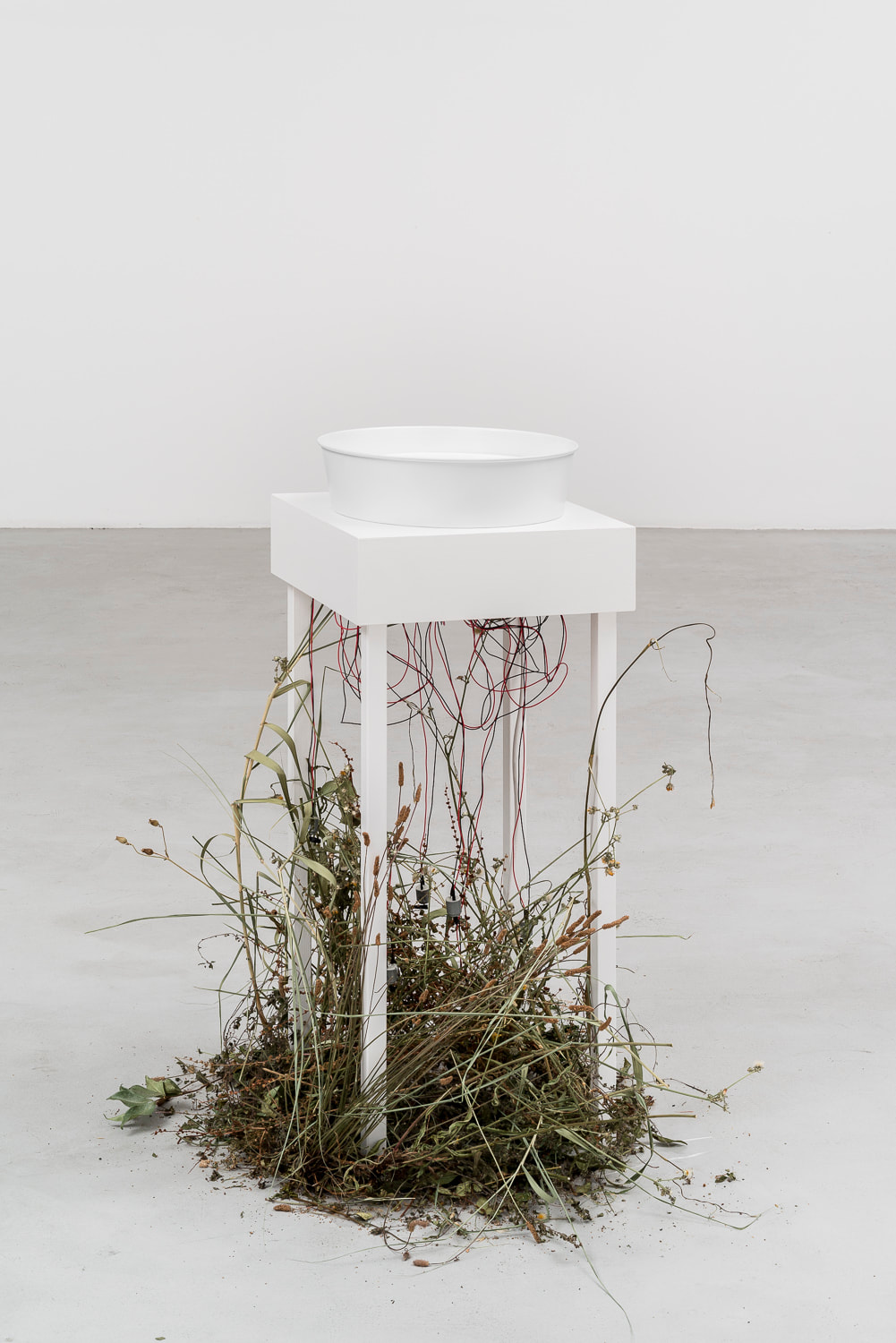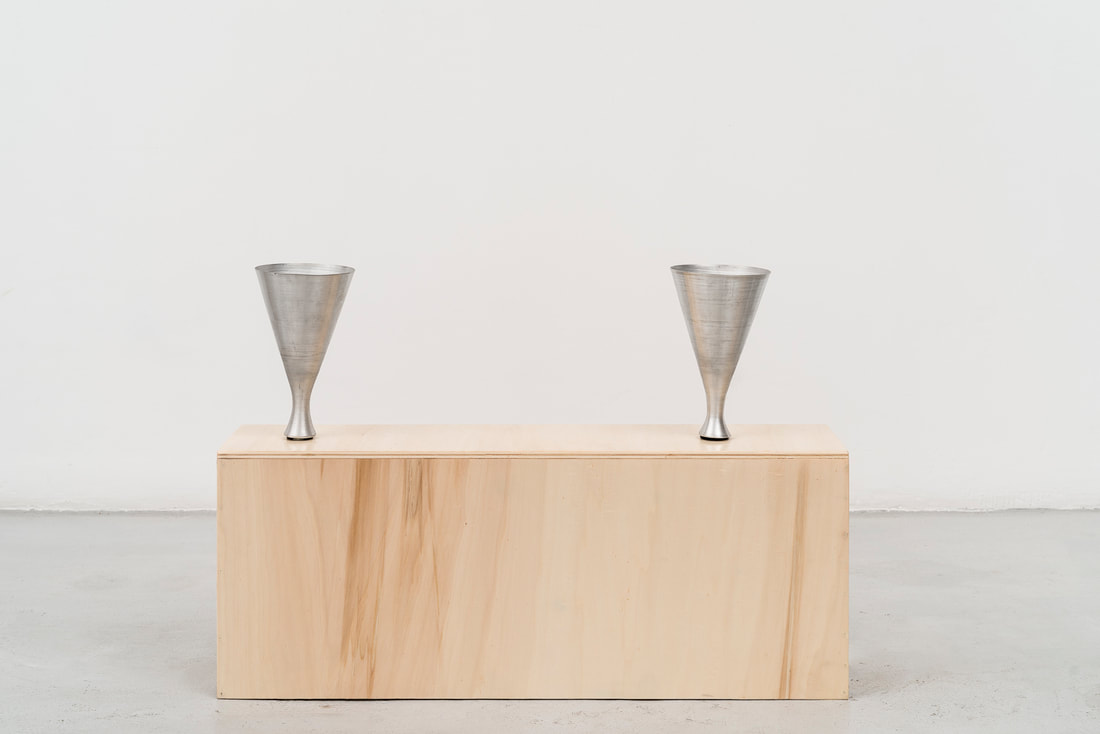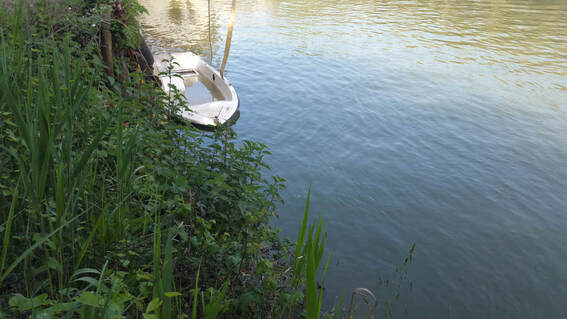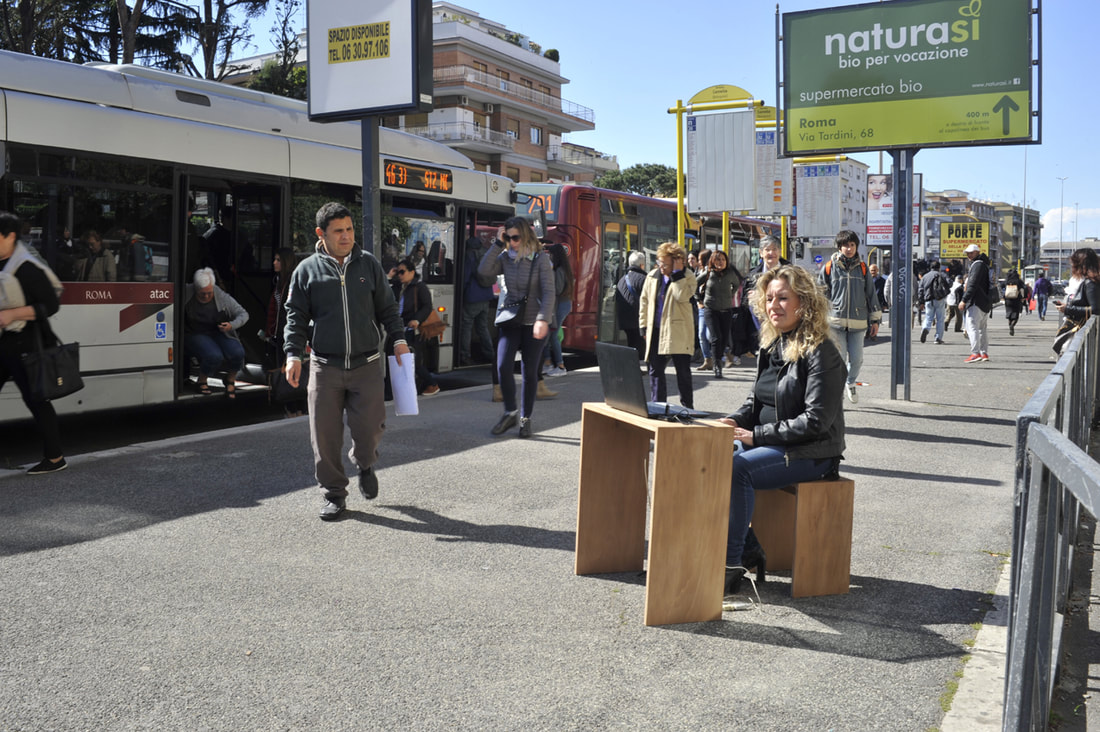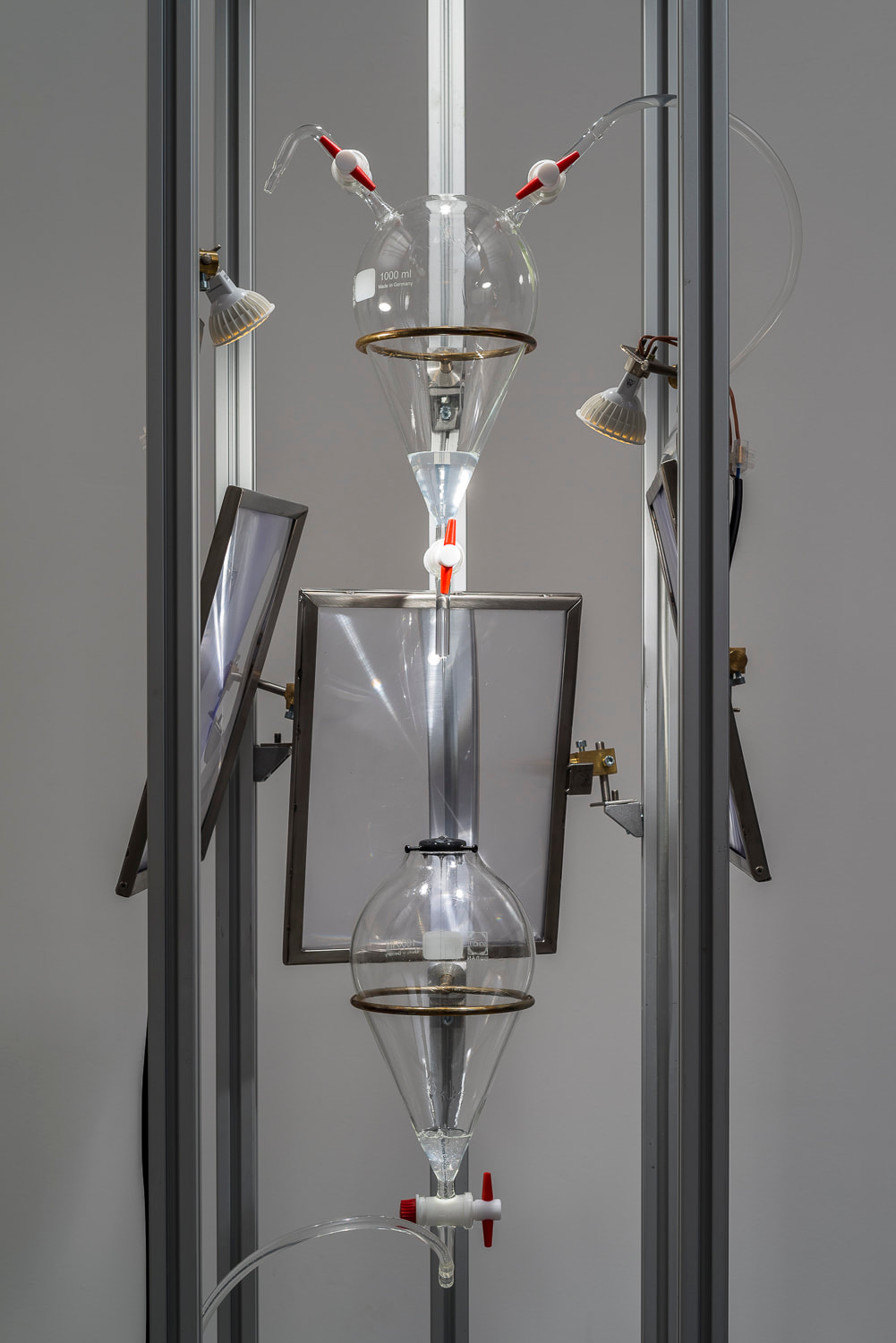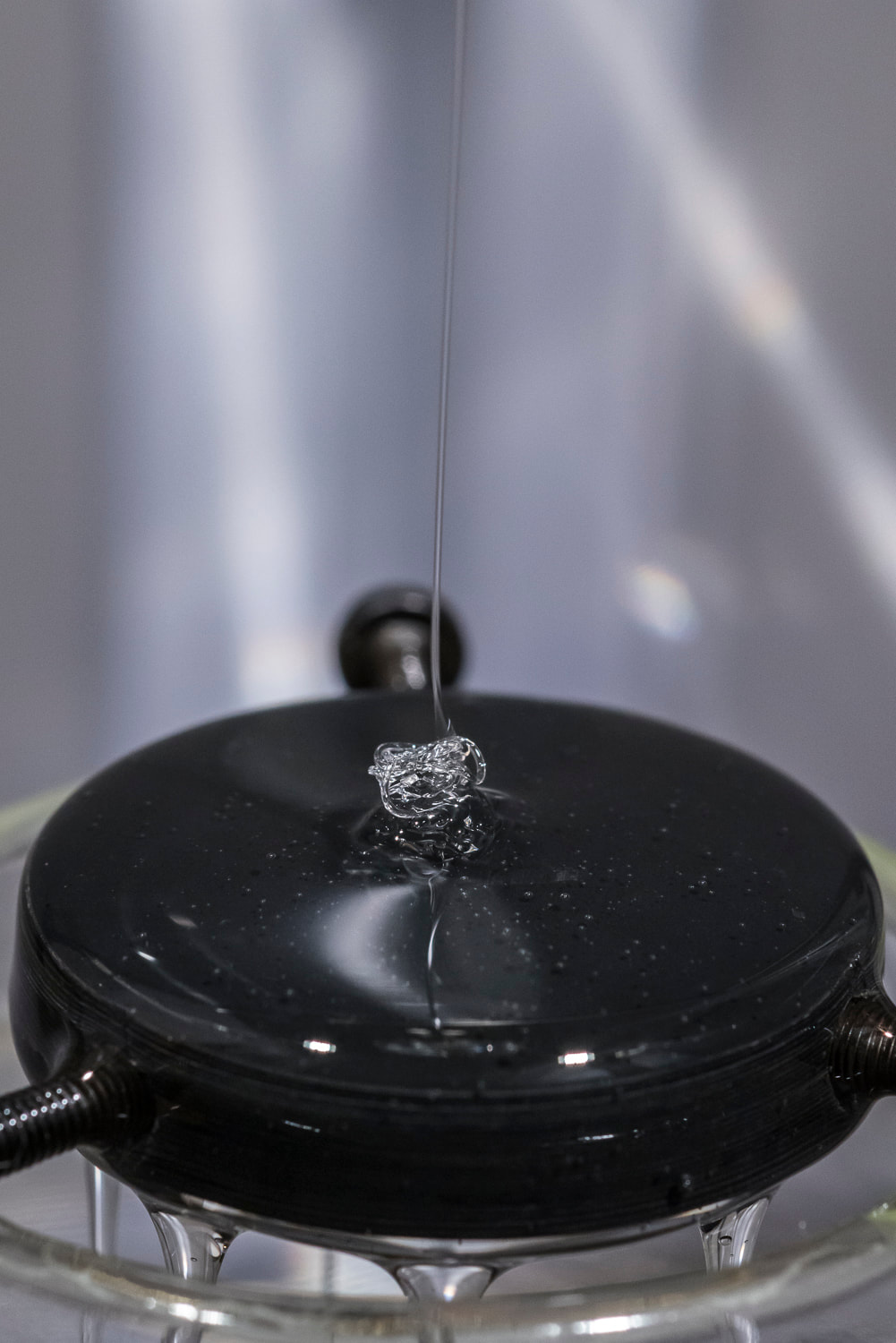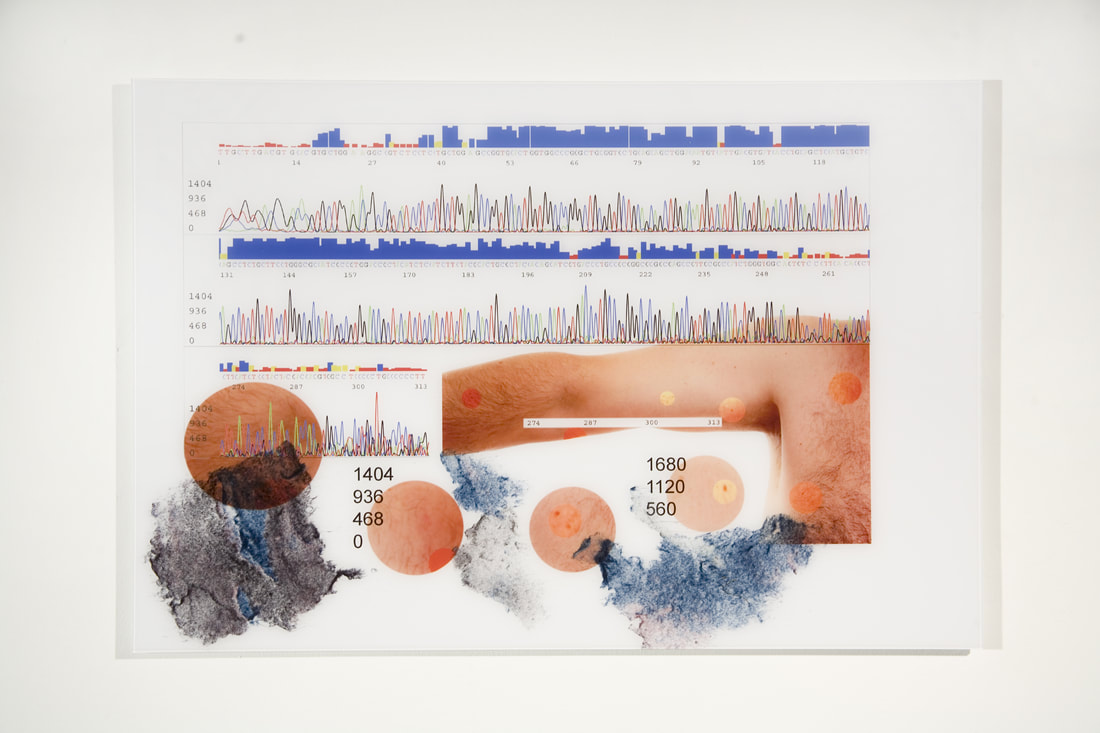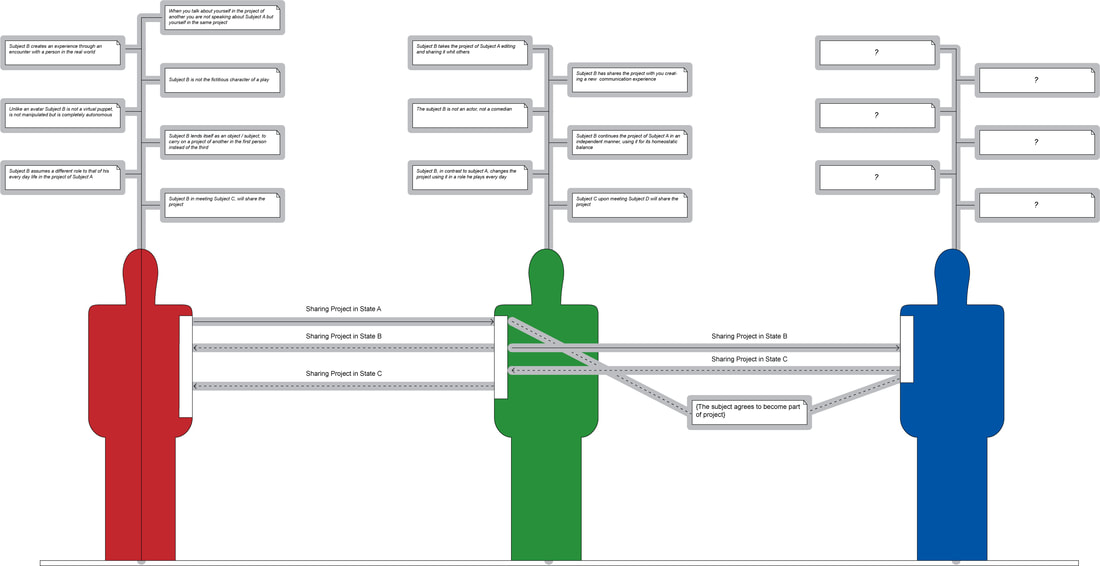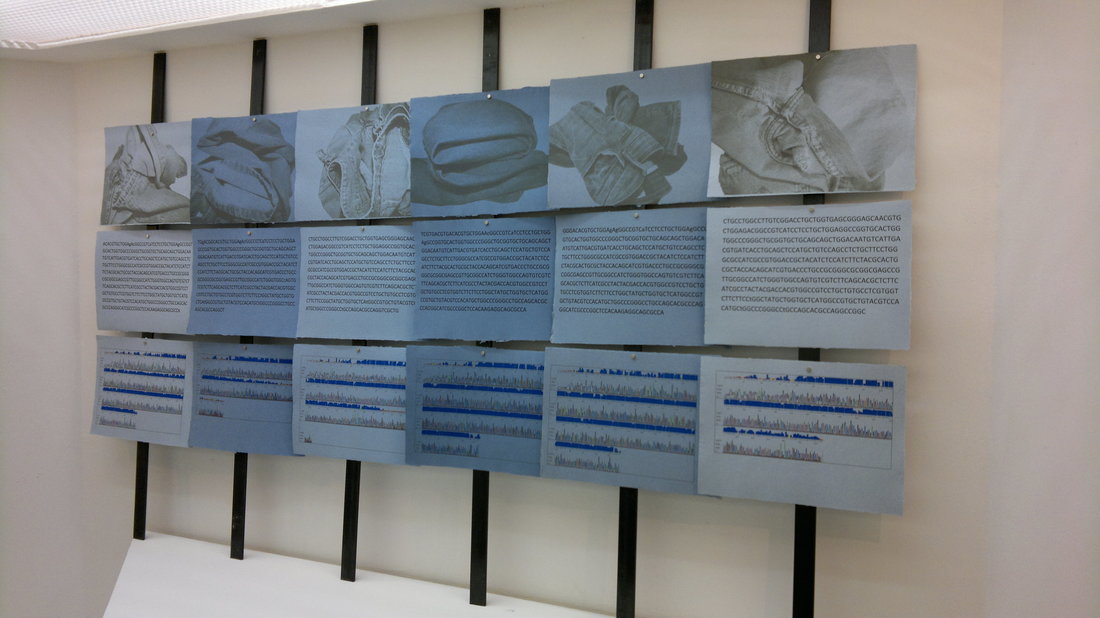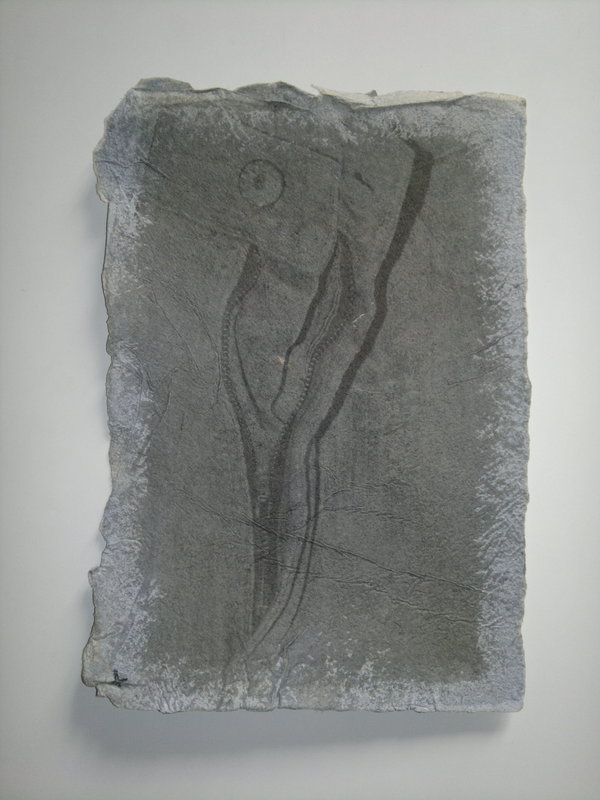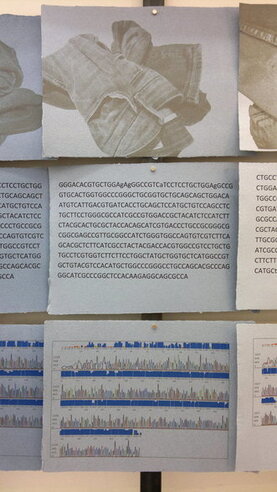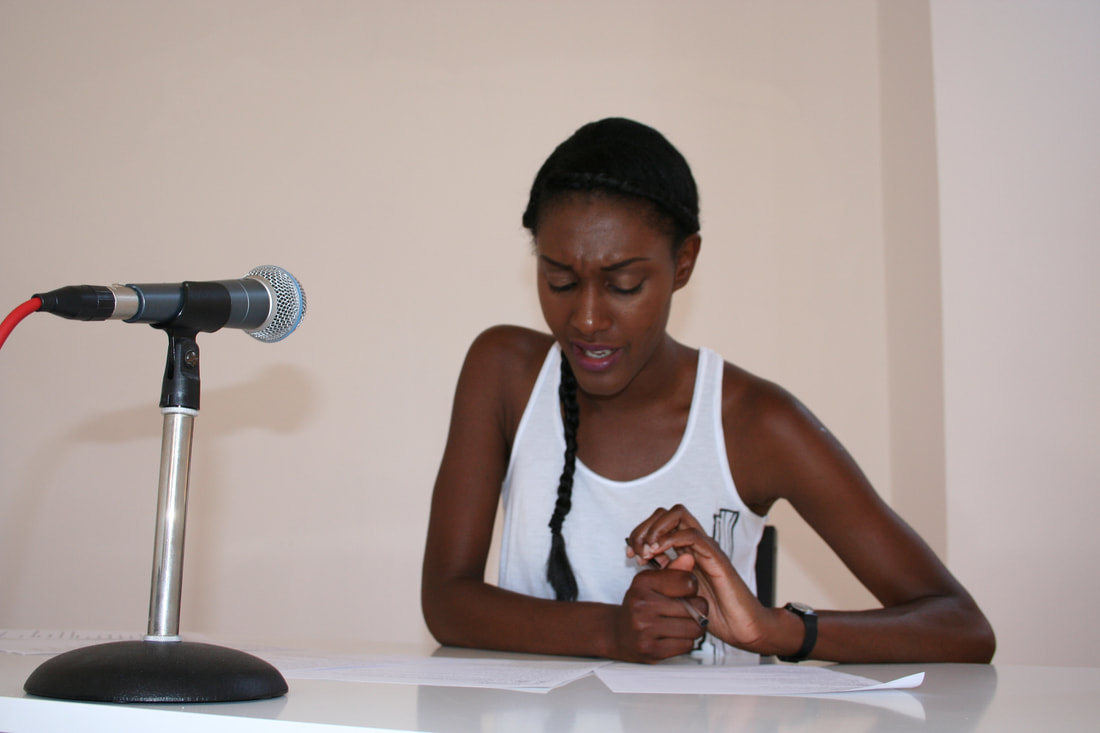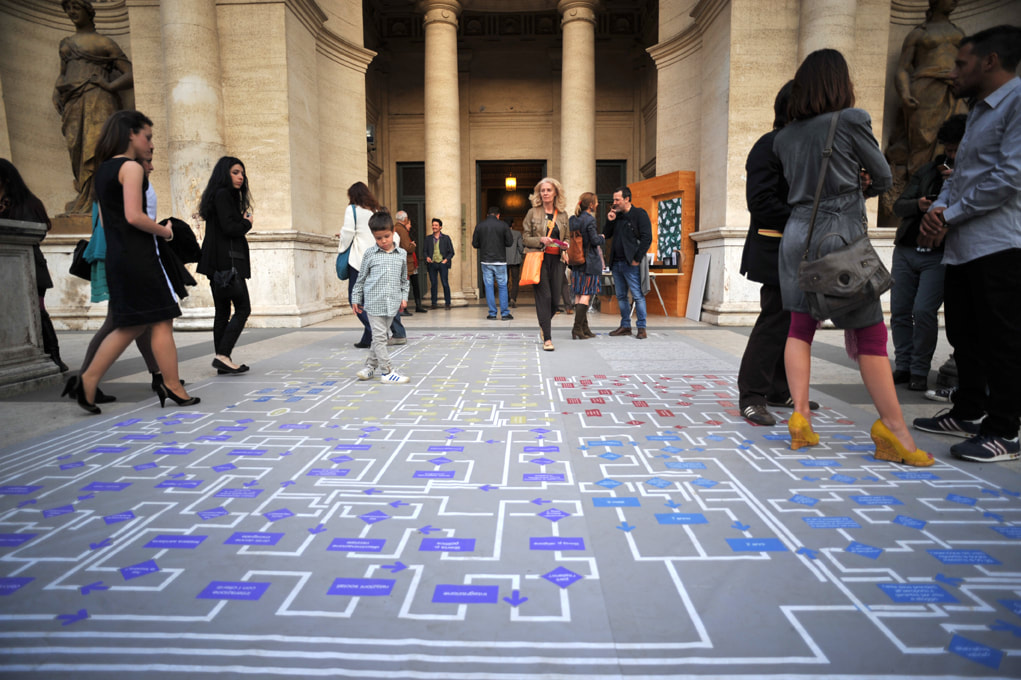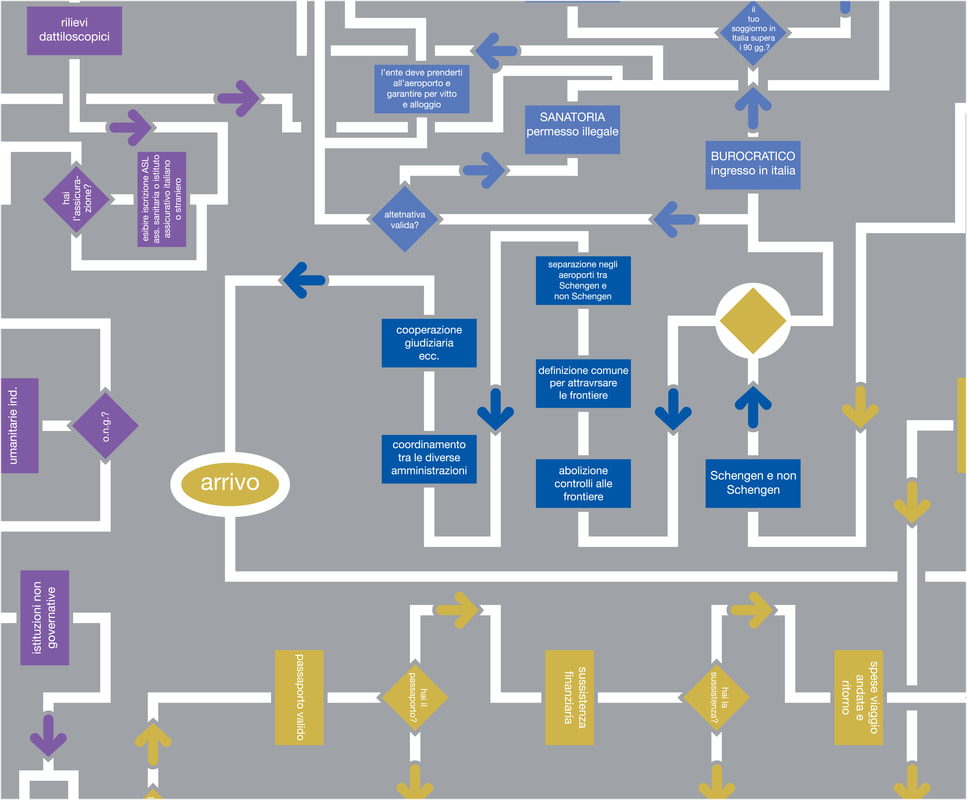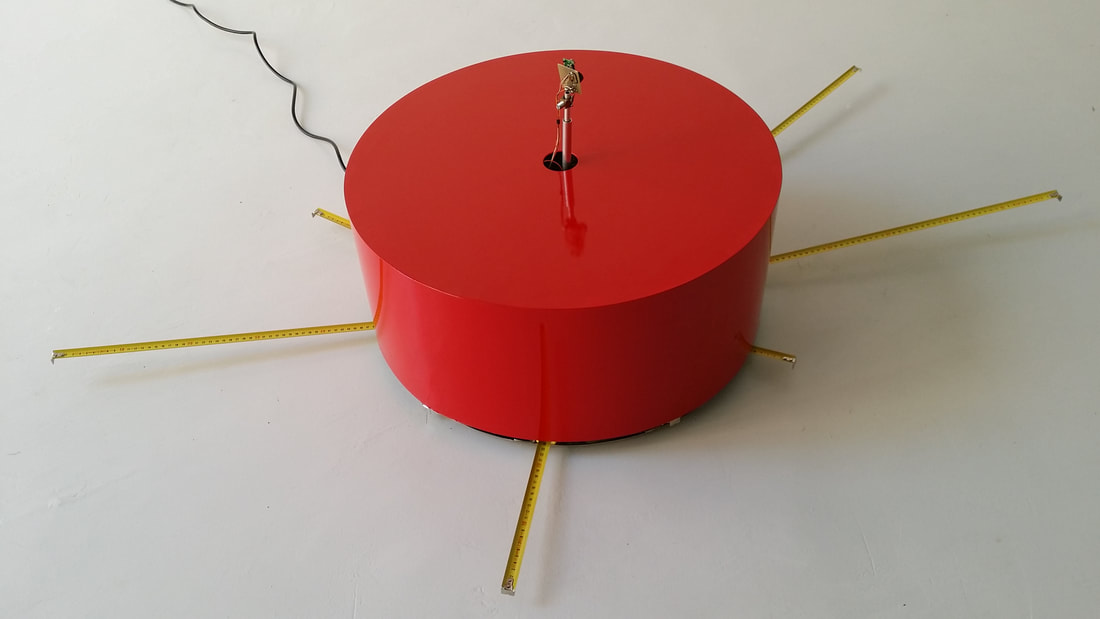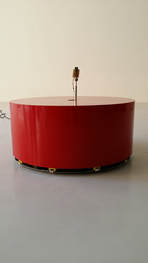Ferro Autarchico / 2020
Monumento agli animali ignoti / 2020
Sneak Peek / 2020
A small root for a plant in the space, a great root for the terrestrial flora, 2019
Una piccola radice per una pianta nello spazio, una grande radice per la flora terrestre, 2019
We are about to colonize new planets and to measure the resistance of the human body for long periods in hostile places. Plants will also accompany us, required for our nourishment and survival. I have built a sort of rudimentary treadmill that simulates phototropism, that is the movement that leads the plant to curve towards the directional light sources. With artificial light the plants will not make an east-west movement during the day following the sun. The gymnastic aspect serves to keep them in shape and reduce stress. From an ironic point of view,this work is a reflection on the role of human sciences and the function of the theory with respect to the decentralization of the human being who no longer measures all things. The ideology of the free market economy has generated the anti-intellectualism that discredits soft science and places salvation and truth in the hard sciences alone.
Ondografo Analogico, 2019
Bluemoon Operation, cucchiaini forati/perforated teaspoons, 2019
The title Bluemoon Operation recalls an undercover operation conducted by the secret services at the beginning of the 1970s,
when heavy drugs, particularly pure heroin at a very low price, were distributed among the population so as to end the generational and political conflicts of the time. The number of heroin addicts in Italy rose from zero in 1970 to 300,000 in 1985. In Rome, between 1973 and 1974, the place where one could buy drugs was Campo de’ Fiori. Bar owners would put holes in their teaspoons as drug addicts repeatedly stole them in order to dissolve the substance. This did not solve their problem, however, as tourists stole the perforated teaspoons as souvenirs. Using this particular detail as his departure point, Caloro has created a series of perforated and engraved teaspoons with the title Bluemoon Operation. These teaspoons will not be exhibited but mixed among the bar’s own cutlery, in this case Caffè Perù, via Monserrato, Rome. The teaspoon thus becomes an emblem of a historical timeframe marked by the tragic diffusion of heavy drugs and an often unwritten page of our contemporary history. Those who will have a coffee between the 7th and 13th of October 2019 at Caffè Perù will find it difficult to scoop cream and sugar from the bottom of their cup, but, at the same time, they will be able to read and remember the complexities of a difficult historical period, not too far from us in time and space.
The title Bluemoon Operation recalls an undercover operation conducted by the secret services at the beginning of the 1970s,
when heavy drugs, particularly pure heroin at a very low price, were distributed among the population so as to end the generational and political conflicts of the time. The number of heroin addicts in Italy rose from zero in 1970 to 300,000 in 1985. In Rome, between 1973 and 1974, the place where one could buy drugs was Campo de’ Fiori. Bar owners would put holes in their teaspoons as drug addicts repeatedly stole them in order to dissolve the substance. This did not solve their problem, however, as tourists stole the perforated teaspoons as souvenirs. Using this particular detail as his departure point, Caloro has created a series of perforated and engraved teaspoons with the title Bluemoon Operation. These teaspoons will not be exhibited but mixed among the bar’s own cutlery, in this case Caffè Perù, via Monserrato, Rome. The teaspoon thus becomes an emblem of a historical timeframe marked by the tragic diffusion of heavy drugs and an often unwritten page of our contemporary history. Those who will have a coffee between the 7th and 13th of October 2019 at Caffè Perù will find it difficult to scoop cream and sugar from the bottom of their cup, but, at the same time, they will be able to read and remember the complexities of a difficult historical period, not too far from us in time and space.
Binding or not-binding committments, performance, 2019
Evo Ensamble: Soprano:Veronica Bartolomei, Mezzosoprano: Virginia Guidi, Tenore: Alessandro Cavazzani,
Baritono: Emanuele Gizzi. Compositore, regista del suono: Edoardo Maria Bellucci Neurofeedback: Dott. Giuseppe Cozzuto
In the performance Binding or not-Binding Commitments by Carlo Caloro, the technique of neurofeedback is used, a non-invasive technique used at neuro-cognitive level to treat certain clinical situations, as in the therapy of pathologies of ADHD or migraines. Normally, in order to register an individual completely, it would be necessary to apply four electrodes on one individual’s scalp. In the performance, by contrast, every singer is supplied with one electrode with the electroencephalographical lines being simultaneously registered and monitored by the same amplificator. If the attention span of the individual singers and the level of empathy is elevated, their voices can be heard from four speakers in one single harmonious song. The work presents itself as a dispositive that trains the cooperation and resolution of conflicts. It offers expression for the contemporary need to construct binding We-communities, in contrast with the spread of individualistic and narcissistic behaviour of the masses, non-binding I-communities.
Evo Ensamble: Soprano:Veronica Bartolomei, Mezzosoprano: Virginia Guidi, Tenore: Alessandro Cavazzani,
Baritono: Emanuele Gizzi. Compositore, regista del suono: Edoardo Maria Bellucci Neurofeedback: Dott. Giuseppe Cozzuto
In the performance Binding or not-Binding Commitments by Carlo Caloro, the technique of neurofeedback is used, a non-invasive technique used at neuro-cognitive level to treat certain clinical situations, as in the therapy of pathologies of ADHD or migraines. Normally, in order to register an individual completely, it would be necessary to apply four electrodes on one individual’s scalp. In the performance, by contrast, every singer is supplied with one electrode with the electroencephalographical lines being simultaneously registered and monitored by the same amplificator. If the attention span of the individual singers and the level of empathy is elevated, their voices can be heard from four speakers in one single harmonious song. The work presents itself as a dispositive that trains the cooperation and resolution of conflicts. It offers expression for the contemporary need to construct binding We-communities, in contrast with the spread of individualistic and narcissistic behaviour of the masses, non-binding I-communities.
The deepest point of the Tiber where death does not exist, 2018
CloneSaver Cards are designed for the long-term, room temperature storage of plasmid and BAC DNA clones from bacterial cultures, resuspended colonies or glycerol stocks. On this special kind of card the watercolor captures the brief moment of infiltration of the water, taken from the Tiber, sealed immediately after drying out. The work operates with the aesthetics of the invisible, because what we see is only the reaction of the water with the special paper, and not the water itself. But the result is a portrait of the river in the double sense - the materia prima, the water of the Tiber, and the accidental flow of the water at the moment of its contact with the paper. The watercolor becomes a scientific document, preserving the quality of the Tiber water with all its microbiological and genetic properties for the next 100 years.
CloneSaver Cards are designed for the long-term, room temperature storage of plasmid and BAC DNA clones from bacterial cultures, resuspended colonies or glycerol stocks. On this special kind of card the watercolor captures the brief moment of infiltration of the water, taken from the Tiber, sealed immediately after drying out. The work operates with the aesthetics of the invisible, because what we see is only the reaction of the water with the special paper, and not the water itself. But the result is a portrait of the river in the double sense - the materia prima, the water of the Tiber, and the accidental flow of the water at the moment of its contact with the paper. The watercolor becomes a scientific document, preserving the quality of the Tiber water with all its microbiological and genetic properties for the next 100 years.
signum monitorium (Latin: buoy, alarm), 2018
A buoy with a GPS receiver inside collecting and transmitting data about its position, latitude, longitude and velocity, is floating on the Tiber. It acts like another piece of floating rubbish, as it traces and records its own route on the river. The collected data is shown on the display together with the images of the routes and the microscopically enlarged particles of the water. The buoy becomes the alter ego of the Tiber, its current and one of its inhabitants. We can follow his position, but like a message in a bottle, there is a risk of loss.
A buoy with a GPS receiver inside collecting and transmitting data about its position, latitude, longitude and velocity, is floating on the Tiber. It acts like another piece of floating rubbish, as it traces and records its own route on the river. The collected data is shown on the display together with the images of the routes and the microscopically enlarged particles of the water. The buoy becomes the alter ego of the Tiber, its current and one of its inhabitants. We can follow his position, but like a message in a bottle, there is a risk of loss.
Pseudomonas aeruginosa, 2018
On April 30th 2018 at 10:00 I took a sample of water along the left bank of the Tiber river near Castel Sant'Angelo. The microbiological analysis revealed the presence of various bacteria harmful to human health. Among these was the pseudomonas aeruginosa: Fruity, grape-like scent or smells like taco chips or tortilla chips (USA), linden blossom and Gummibärchen (GER) and profumo di uva (ITA). Metallic sheen with hints of blue/green due to pyocyanin pigment; Dry, flat and spreading; Non-lactose fermenter on MacConkey Agar; Gram-negative bacilli/rod; Part of the Enterobacteriaceae family; Common cause of burn and wound infections, UTI's, associated with formation of kidney stones, causative agent of otitis externa or "Swimmer's Ear", common cause of skin infections.
On April 30th 2018 at 10:00 I took a sample of water along the left bank of the Tiber river near Castel Sant'Angelo. The microbiological analysis revealed the presence of various bacteria harmful to human health. Among these was the pseudomonas aeruginosa: Fruity, grape-like scent or smells like taco chips or tortilla chips (USA), linden blossom and Gummibärchen (GER) and profumo di uva (ITA). Metallic sheen with hints of blue/green due to pyocyanin pigment; Dry, flat and spreading; Non-lactose fermenter on MacConkey Agar; Gram-negative bacilli/rod; Part of the Enterobacteriaceae family; Common cause of burn and wound infections, UTI's, associated with formation of kidney stones, causative agent of otitis externa or "Swimmer's Ear", common cause of skin infections.
Myim telescopic umbrellas, 2018
The Hebrew word myim deriving from the book of Genesis means: primordial water, of river, of rain, of spring and also sperm, blood (menstruation), tears and urine. On a "digital display" made of telescopic umbrellas, of low cost manufacturing, the word reappears here diluted and senseless in the flow of the digital commercial and financial exchanges that are impermeable to water. Closed umbrellas predict future conflicts for drinking water and given the distance between the characters MY and IM, the message can also be read as MY and I AM which refer to the liquidity generated by greed and selfishness of producers, traders and consumers disrespectful of the environment.
The Hebrew word myim deriving from the book of Genesis means: primordial water, of river, of rain, of spring and also sperm, blood (menstruation), tears and urine. On a "digital display" made of telescopic umbrellas, of low cost manufacturing, the word reappears here diluted and senseless in the flow of the digital commercial and financial exchanges that are impermeable to water. Closed umbrellas predict future conflicts for drinking water and given the distance between the characters MY and IM, the message can also be read as MY and I AM which refer to the liquidity generated by greed and selfishness of producers, traders and consumers disrespectful of the environment.
Agòn kinetic sculpture, 2018
Hidden in plain sight performance, 2018
The river Tiber may perhaps be considered as the largest museum that the city possesses and that hides in great sight immense archaeological treasures. It is an inaccessible collective memory, a blind spot similar to that of the eye where there is an area of the retina that sees absolutely nothing. A light bulb is immersed in the water. It is a metaphorical gesture which leads us to experience a reversed vision towards the depth by overcoming the visible membrane, represented by the surface of the water. The surface of the river is thus backlit. A new image presents itself from a new perspective. The curiosity is such as to imagine how much the view is hidden by water: the river's flora and fauna, waste, microbiological organisms, bacteria, etc., the imagination is the retina containing the receptors needed to "shed light" beyond blind spots.
Absorption kinetic sculpture, 2018
A small boat abandoned on the banks of the Tiber was fished out and specially prepared so that it can sink and re-emerge within 30 minutes.
When the small boat is absorbed by the water it appears as a two-dimensional shape turning into a floating frame. The attention field shrinks. Within the frame are captured an infinity of ephemeral fluid images created by the river and all that its waters carry with themselves. When the small boat re-emerges and floats the frame vanishes and with it the images, hence what remains is the memory of the soft matter of the concepts.
If the life of the human being is similar to the river with its continuous flow of an apparent dichotomy between transience and transformation, things and being are nothing but fluctuating waves, floating and multidimensional water bodies that sink and re-emerge, that act and react simultaneously on a physical, emotional and mental level, where the modification of each element involves the change of all the connected parts.
A small boat abandoned on the banks of the Tiber was fished out and specially prepared so that it can sink and re-emerge within 30 minutes.
When the small boat is absorbed by the water it appears as a two-dimensional shape turning into a floating frame. The attention field shrinks. Within the frame are captured an infinity of ephemeral fluid images created by the river and all that its waters carry with themselves. When the small boat re-emerges and floats the frame vanishes and with it the images, hence what remains is the memory of the soft matter of the concepts.
If the life of the human being is similar to the river with its continuous flow of an apparent dichotomy between transience and transformation, things and being are nothing but fluctuating waves, floating and multidimensional water bodies that sink and re-emerge, that act and react simultaneously on a physical, emotional and mental level, where the modification of each element involves the change of all the connected parts.
…ruet moles et machina mundi kinetic sculpture, 2017
…the mass and fabric of the world, shall crash into ruins (Lucretius De Rerum Natura, V 95-6).
An air tube connected to a compressor generates the dangerous movement of a whip, the end of which is connected to a loose red-white danger tape. The uncontrolled movement of the thin tube is like a device meant to signal the imminent collapse of the machina mundi. The human being has constructed the immense building of the world starting with his body as the first available technology, improving its condition with the production of other practices like those of language and writing. In its ephemerality, the dynamics of the machine of culture creates conditions of a precarious balance between progress and regression, uninterruptedly causing situations of peril that signal us: Attention! Risk of danger!
…the mass and fabric of the world, shall crash into ruins (Lucretius De Rerum Natura, V 95-6).
An air tube connected to a compressor generates the dangerous movement of a whip, the end of which is connected to a loose red-white danger tape. The uncontrolled movement of the thin tube is like a device meant to signal the imminent collapse of the machina mundi. The human being has constructed the immense building of the world starting with his body as the first available technology, improving its condition with the production of other practices like those of language and writing. In its ephemerality, the dynamics of the machine of culture creates conditions of a precarious balance between progress and regression, uninterruptedly causing situations of peril that signal us: Attention! Risk of danger!
Repubblica del fare di tutti e di ciascuno Performance, 2017
In the open public place on a small table a stenotype is placed, similar to the ones in use at the Hall of the Senate of the Republic for the purpose of recording the speeches of senators in the assembly. During this performance, the stenotypist will create a textual “panoramic” image that will record the rhythm and impulses of what vital and relational occurrences will take place around her. The result will be an imperfect testimony, a sketch of the anonymous and invisible words and actions of all those present - the individuals who, living in the same environment, construct and deconstruct the democratic order of their everyday life, motioned by the interests and disinterests they hold in common.
In the open public place on a small table a stenotype is placed, similar to the ones in use at the Hall of the Senate of the Republic for the purpose of recording the speeches of senators in the assembly. During this performance, the stenotypist will create a textual “panoramic” image that will record the rhythm and impulses of what vital and relational occurrences will take place around her. The result will be an imperfect testimony, a sketch of the anonymous and invisible words and actions of all those present - the individuals who, living in the same environment, construct and deconstruct the democratic order of their everyday life, motioned by the interests and disinterests they hold in common.
| txt_repubblica_del_fare_di_tutti_e_di_ciascuno.pdf |
Disoccupazione del suolo pubblico pannello pubblicitario, banchetto di cartone, 2017
Typically, the street vendor illegally occupies public ground. His display counter is ephemeral, light and designed to be folded in just a few moments and “disappear”, along with the merchandise presented on it. Pedestal and countertop, both made of cardboard, form thus an easily transportable shop, replete with handles - the artisanal, homemade quality of which stands in sharp contrast with the industrially, serially produced low-cost products exhibited for sale. Armed with this equipment, these street vendors appear wherever in the city they sense a prospect of finding buyers. In the installation, the folded cardboard counter maintains its distinction of illegality in occupying public ground without licenses of any kind. The cardboard counter and the photograph exhibited on the billboard lose the distinction of artwork and of value, dodging both the regulations that define the activity of peddling and those of art-making, through a dis-occupation of public ground.
Typically, the street vendor illegally occupies public ground. His display counter is ephemeral, light and designed to be folded in just a few moments and “disappear”, along with the merchandise presented on it. Pedestal and countertop, both made of cardboard, form thus an easily transportable shop, replete with handles - the artisanal, homemade quality of which stands in sharp contrast with the industrially, serially produced low-cost products exhibited for sale. Armed with this equipment, these street vendors appear wherever in the city they sense a prospect of finding buyers. In the installation, the folded cardboard counter maintains its distinction of illegality in occupying public ground without licenses of any kind. The cardboard counter and the photograph exhibited on the billboard lose the distinction of artwork and of value, dodging both the regulations that define the activity of peddling and those of art-making, through a dis-occupation of public ground.
Soft Hard silicone sculpture, 2015
A thin stream of silicone liquid with a coefficient of viscosity of 30000 cSt flowing coiling on itself on a stationary surface creating a cylinder of fluid cable. The cylinder grows, reaches a critical height and collapses and the process begins again. Three lenses applied to the theca, one of them magnifies two and a half times the original size of the thin stream and the other two are directed towards the outside of the theca in the direction of the collection of books in the library. Which is the role of the human Sciences and the function of the theory compared to the decentralization of the human being who is no longer measure of all things? The ideology of the free market economy has generated the antiintellectualism that discredits the soft science and removing the value theory. It ‘a process where the fluid of soft and hard knowledge breaks up and reorganizes themselves cyclically.
A thin stream of silicone liquid with a coefficient of viscosity of 30000 cSt flowing coiling on itself on a stationary surface creating a cylinder of fluid cable. The cylinder grows, reaches a critical height and collapses and the process begins again. Three lenses applied to the theca, one of them magnifies two and a half times the original size of the thin stream and the other two are directed towards the outside of the theca in the direction of the collection of books in the library. Which is the role of the human Sciences and the function of the theory compared to the decentralization of the human being who is no longer measure of all things? The ideology of the free market economy has generated the antiintellectualism that discredits the soft science and removing the value theory. It ‘a process where the fluid of soft and hard knowledge breaks up and reorganizes themselves cyclically.
Nice to Meet Me performance, 2012—2013
Carlo Caloro makes a theme of the persistent gathering of information about us that no longer provides protection by separating what is public from what is our private lives. Points cards when we shop, data that incur when using the computer that is limitlessly connected to the Internet, as well as connections when we telephone, make us to monitored beings, from which profiles of our actions and movements may be compiled. Via the collected traces of our consumer behavior, personal details become commercial goods, information from which an image of our persons may be constructed. The possibility of DNA-identifications from the minutest traces we leave behind each day the moment we extend a hand or drink something enables a further decoding of our most personal details. At the same time, however, Caloro questions whether all of this, in particular the information having to do with our genes, which is easily obtainable through spying, may indeed reflect our personality On the basis of experimentally gathered data of traces of an unknown individual on a plastic cup that was found, Caloro had an image made from characteristics that it was possible to glean from this. Does this already constitute a reconstruction of our personality? In a performance, an actor personifies these characteristics in a real context, a casual celebration with all its unpredictable encounters and the resulting interactions that come about among people meeting one another. The random, spontaneous questions and conversation topics of the guests dash against the texts of the actor, which had been pre-formulated as hypothetical thoughts, the resulting elements of conversation stemming from the knowledge of his presumed genetically predetermined personality. It is up to the performance visitor to experience the consequences of the social interaction and draw his or her conclusions from it.
Carlo Caloro makes a theme of the persistent gathering of information about us that no longer provides protection by separating what is public from what is our private lives. Points cards when we shop, data that incur when using the computer that is limitlessly connected to the Internet, as well as connections when we telephone, make us to monitored beings, from which profiles of our actions and movements may be compiled. Via the collected traces of our consumer behavior, personal details become commercial goods, information from which an image of our persons may be constructed. The possibility of DNA-identifications from the minutest traces we leave behind each day the moment we extend a hand or drink something enables a further decoding of our most personal details. At the same time, however, Caloro questions whether all of this, in particular the information having to do with our genes, which is easily obtainable through spying, may indeed reflect our personality On the basis of experimentally gathered data of traces of an unknown individual on a plastic cup that was found, Caloro had an image made from characteristics that it was possible to glean from this. Does this already constitute a reconstruction of our personality? In a performance, an actor personifies these characteristics in a real context, a casual celebration with all its unpredictable encounters and the resulting interactions that come about among people meeting one another. The random, spontaneous questions and conversation topics of the guests dash against the texts of the actor, which had been pre-formulated as hypothetical thoughts, the resulting elements of conversation stemming from the knowledge of his presumed genetically predetermined personality. It is up to the performance visitor to experience the consequences of the social interaction and draw his or her conclusions from it.
|
|
|
Lumpenwringer Kinetic Sculptur, 2013 -2014
A scythe-shaped aluminium arch 3 metres high and 5 metres wide is set on the floor with the two ends pointing upwards. Two electric motors are installed on the tips, to wring and unroll a strip of cloth 15 metres long. At the bottom of the arch there is a container full of water. The cloth gets soaked in water, is wrung by the motors and after being unrolled, drops back into the water. This process of rolling and unrolling is repeated regularly. The device recalls the machines that test the resistance of products, going through the same actions in a loop pattern. This work and the resulting associations regard our own being, and Caloro reflects on how our life is conditioned by measure, by the measurable, by systems of measurement and by measuring. This is Carlo Caloro’s stimulating conclusion: “But if there is a measure, there is also and an external measure, something measureless extending to that which is not measurable: the boundless”. Starting from his reflections on the relationship between man and machines, on materialism and the repercussions on our way of life, Caloro raises the issue of the difference between a living organism with its goals and a type of behaviour to achieve them, and a machine without its own goals just like the “rag wringer”. The work is a critique on the “cage” of day-to-day life in which we are confined with the constant repetition of rhythms alternating between opposite poles, actions repeated in an identical way and with a constant movement, subject to the pressure of never being able to stop and with a constant struggle to maintain balance and stability. In the world of work, we are forced to compete with machines, their programmed rhythms and their predictability.
A scythe-shaped aluminium arch 3 metres high and 5 metres wide is set on the floor with the two ends pointing upwards. Two electric motors are installed on the tips, to wring and unroll a strip of cloth 15 metres long. At the bottom of the arch there is a container full of water. The cloth gets soaked in water, is wrung by the motors and after being unrolled, drops back into the water. This process of rolling and unrolling is repeated regularly. The device recalls the machines that test the resistance of products, going through the same actions in a loop pattern. This work and the resulting associations regard our own being, and Caloro reflects on how our life is conditioned by measure, by the measurable, by systems of measurement and by measuring. This is Carlo Caloro’s stimulating conclusion: “But if there is a measure, there is also and an external measure, something measureless extending to that which is not measurable: the boundless”. Starting from his reflections on the relationship between man and machines, on materialism and the repercussions on our way of life, Caloro raises the issue of the difference between a living organism with its goals and a type of behaviour to achieve them, and a machine without its own goals just like the “rag wringer”. The work is a critique on the “cage” of day-to-day life in which we are confined with the constant repetition of rhythms alternating between opposite poles, actions repeated in an identical way and with a constant movement, subject to the pressure of never being able to stop and with a constant struggle to maintain balance and stability. In the world of work, we are forced to compete with machines, their programmed rhythms and their predictability.
Soglie, 2013
The characteristic of borderline spaces is that they are on the border between different dimensions, substantially between daily life and a different time, the one connected with the function people happen to be fulfilling. This is why many of the spaces we are talking about can trigger a change in status, often temporary, bound to finish as soon as the function for which these spaces have been created ends, and will be recreated as soon as that function is needed again. Just to take an example, there is the dressing room in the theatre; it visually and conceptually creates the actor or actress using it, and has the function of both preparing the a characterand of bringing the actors back to the status of an “private person” after the performance is over. Some examples included in the photographs: airports/passengers; hospital surgeries/patients; school halls/students; bus terminals/commuters; seaside cabins/bathers; gym changing rooms/sports practitioners; etc. Similarly, the member of the public who crosses the threshold into the gallery where the photos are displayed acquires the socially approved status of a visitor. The visitor is the living completion of the work of art. The main function of our contemporary super-specialised society is to optimise consumption, and as a result contemporary art is increasingly pushed to serve the market rather than culture. This is why I found it indispensable to measure the habits and behaviour of visitors through specific electronic instruments consisting of sensors and displays where we can read data on movements, distance and time the visitors stop in front of an exhibit. The electronic devices are visible and hanging next to the photos on display. The experience of the person who is a member of the public and a visitor cannot be evaluated and measured by the electronic instruments, but just observed in real time through interactive communication.
The characteristic of borderline spaces is that they are on the border between different dimensions, substantially between daily life and a different time, the one connected with the function people happen to be fulfilling. This is why many of the spaces we are talking about can trigger a change in status, often temporary, bound to finish as soon as the function for which these spaces have been created ends, and will be recreated as soon as that function is needed again. Just to take an example, there is the dressing room in the theatre; it visually and conceptually creates the actor or actress using it, and has the function of both preparing the a characterand of bringing the actors back to the status of an “private person” after the performance is over. Some examples included in the photographs: airports/passengers; hospital surgeries/patients; school halls/students; bus terminals/commuters; seaside cabins/bathers; gym changing rooms/sports practitioners; etc. Similarly, the member of the public who crosses the threshold into the gallery where the photos are displayed acquires the socially approved status of a visitor. The visitor is the living completion of the work of art. The main function of our contemporary super-specialised society is to optimise consumption, and as a result contemporary art is increasingly pushed to serve the market rather than culture. This is why I found it indispensable to measure the habits and behaviour of visitors through specific electronic instruments consisting of sensors and displays where we can read data on movements, distance and time the visitors stop in front of an exhibit. The electronic devices are visible and hanging next to the photos on display. The experience of the person who is a member of the public and a visitor cannot be evaluated and measured by the electronic instruments, but just observed in real time through interactive communication.
Apaf1_Bcl2, 2012 kinetic sculpture, 2012
The topic of this machine is Caloro’s attempt to come to terms with sensory balance, derived from genetics. The kinetic sculpture, with an overall height of 3.60 meters and a diameter of 30 cm, consists of a lower part, the base, as well as an upper part, which Caloro refers to as an extremity,
a fact that already invites a comparison with the human body. These two components are composed of carbon fiber rods, and are linked by a middle part of Plexiglas. In this transparent tube there are two motors and an electronic control board, which work together to make the upper extremity tilt. Further material contributing to this are the characters of two of Caloro’s genes that have been stored on the control board. These two genes, Apaf1 and Bcl2, are what give the sculpture its title; they are significant for the development of the inner ear as an organ of balance, the malfunction of which may cause dizziness. With this sculpture, the interest in the relationship between man and machine that runs though Caloro’s work is also present in the perception, which has already been filtered by our expectations. It leads us almost automatically to the question of why the machine acts this way and not in another way—a question we also ask when we wish to gain an understanding of our human counterparts.
The topic of this machine is Caloro’s attempt to come to terms with sensory balance, derived from genetics. The kinetic sculpture, with an overall height of 3.60 meters and a diameter of 30 cm, consists of a lower part, the base, as well as an upper part, which Caloro refers to as an extremity,
a fact that already invites a comparison with the human body. These two components are composed of carbon fiber rods, and are linked by a middle part of Plexiglas. In this transparent tube there are two motors and an electronic control board, which work together to make the upper extremity tilt. Further material contributing to this are the characters of two of Caloro’s genes that have been stored on the control board. These two genes, Apaf1 and Bcl2, are what give the sculpture its title; they are significant for the development of the inner ear as an organ of balance, the malfunction of which may cause dizziness. With this sculpture, the interest in the relationship between man and machine that runs though Caloro’s work is also present in the perception, which has already been filtered by our expectations. It leads us almost automatically to the question of why the machine acts this way and not in another way—a question we also ask when we wish to gain an understanding of our human counterparts.
Piedi Plaster casts, calipers, 2011
For the installation Piedi, the artist had plaster casts made of his feet, and combined these with calipers. Brutally, the tool's slides dig into the plaster foot, getting a fast grip on it and damaging its surface. Caloro has created a strong metaphor here. In this instance the hint of violence in measuring the feet, linked with a restricting of the freedom of movement, gives rise to a comparison with an unpleasant development in our social situation: people today are increasingly subjected to constant social control, evaluation, classification, as well as the pressure of optimization. In keeping with the motto of "Bigger, faster, further" the longing for freedom and limitless opportunity tips into compulsion, pressure, restriction, and excessive demands.
For the installation Piedi, the artist had plaster casts made of his feet, and combined these with calipers. Brutally, the tool's slides dig into the plaster foot, getting a fast grip on it and damaging its surface. Caloro has created a strong metaphor here. In this instance the hint of violence in measuring the feet, linked with a restricting of the freedom of movement, gives rise to a comparison with an unpleasant development in our social situation: people today are increasingly subjected to constant social control, evaluation, classification, as well as the pressure of optimization. In keeping with the motto of "Bigger, faster, further" the longing for freedom and limitless opportunity tips into compulsion, pressure, restriction, and excessive demands.
Nilanka drawing, 2011
For a certain period of time Caloro communicated by means of drawings with a young man from Sri Lanka who had just arrived in Rome and did not speak either Italian, English or German, the languages spoken by the artist. The Nilanka drawings express existential desires, dreams and hopes using a narrative language and minimalist symbolism. The exchange of drawings between Caloro and Nilanka enabled them to overcome language barriers and be able to understand each other. Some of the drawings go far beyond the symbolic and universal language but are still comprehensible. In this case, the drawings substitute direct communication and convey information on a deeper, more intimate level. Although the exchange is not immediate and leaves room for interpretation, the protagonists actually understood each other better than through a conventional conversation.
For a certain period of time Caloro communicated by means of drawings with a young man from Sri Lanka who had just arrived in Rome and did not speak either Italian, English or German, the languages spoken by the artist. The Nilanka drawings express existential desires, dreams and hopes using a narrative language and minimalist symbolism. The exchange of drawings between Caloro and Nilanka enabled them to overcome language barriers and be able to understand each other. Some of the drawings go far beyond the symbolic and universal language but are still comprehensible. In this case, the drawings substitute direct communication and convey information on a deeper, more intimate level. Although the exchange is not immediate and leaves room for interpretation, the protagonists actually understood each other better than through a conventional conversation.
Laniccia Mixed media on aludibond, diasec, 68.5 x 46 cm, 2011
In a pseudo-scientific manner, the artist here combines fuzz from his dryer that had come into daily contact with his skin with self-portraits and chromatograms of the gene MC1R on plastic panels. On the one hand, the picture panels are reminiscent of medicinal-scientific charts, and on the other, we may find in them advertising strategies for care products. Here Caloro is playing with the viewer's expectations, which are influenced by the image language of the new media. Instead of providing information, the artist avoids plausible contexts, however, and thus, subverts any functional value of the charts.
In a pseudo-scientific manner, the artist here combines fuzz from his dryer that had come into daily contact with his skin with self-portraits and chromatograms of the gene MC1R on plastic panels. On the one hand, the picture panels are reminiscent of medicinal-scientific charts, and on the other, we may find in them advertising strategies for care products. Here Caloro is playing with the viewer's expectations, which are influenced by the image language of the new media. Instead of providing information, the artist avoids plausible contexts, however, and thus, subverts any functional value of the charts.
Io_nel_progetto_di_un_altro plexiglass sculpture, 2011
With the aid of a three-dimensional diagram constructed of Plexiglass, the artist demonstrates the process of a performance using the modeling language UML. In the performance visualized here, it is not the machine that replaces people, which is what we experience today. Instead, Caloro turns the phenomenon around, and causes people to replace machines, or respectively, computers. Thus, a person becomes the medium of an Other and his intention. The manner this passed-on information is conveyed by the second, autonomous person differs, despite the objectivity demanded by the computer, since the human medium thinks and feels individually.
With the aid of a three-dimensional diagram constructed of Plexiglass, the artist demonstrates the process of a performance using the modeling language UML. In the performance visualized here, it is not the machine that replaces people, which is what we experience today. Instead, Caloro turns the phenomenon around, and causes people to replace machines, or respectively, computers. Thus, a person becomes the medium of an Other and his intention. The manner this passed-on information is conveyed by the second, autonomous person differs, despite the objectivity demanded by the computer, since the human medium thinks and feels individually.
Natura Morta Fruit and vegetable installation with calipers, 2011
In another installation, Caloro combines the calipers with fruit and vegetables, creating a curious composition a Natura Morta. Consciously opting for the Italian title of what is known in English as the "still life", the artist increases the tragedy of the natural products, which will spoil during the time they are exhibited. What is shown here as a staged, and at the same time natural, process is pitted critically opposite the normative forces of the food industry. The calipers ensure that our thoughts remain with the norm measures we use for fruit and vegetables while they take their natural course, dry up, shrink, and therefore, evade the strict demands of the market.
In another installation, Caloro combines the calipers with fruit and vegetables, creating a curious composition a Natura Morta. Consciously opting for the Italian title of what is known in English as the "still life", the artist increases the tragedy of the natural products, which will spoil during the time they are exhibited. What is shown here as a staged, and at the same time natural, process is pitted critically opposite the normative forces of the food industry. The calipers ensure that our thoughts remain with the norm measures we use for fruit and vegetables while they take their natural course, dry up, shrink, and therefore, evade the strict demands of the market.
Clothing Digital print on handmade paper, chromatogram on paper, 2011
For the work on paper, Clothing, Caloro photographed the various jeans worn by six people, subsequently having each pair of jeans processed into a different piece of handmade paper, upon which in turn he printed the photograph of the corresponding jeans. He then supplemented each with a chromatogram of the gene MC1R, which contains the genetic information of the six jeans-wearers in terms of how they react to ultraviolet light, a factor that determines skin color and pigmentation. As an indicator of the personal characteristic features, the scientific complexity of the DNA is juxtaposed here with the jeans. With this work, Caloro has created portraits, which provide extremely precise information about the respective persons despite the fact that they are absent - it is an abstract representation of human individuals.
For the work on paper, Clothing, Caloro photographed the various jeans worn by six people, subsequently having each pair of jeans processed into a different piece of handmade paper, upon which in turn he printed the photograph of the corresponding jeans. He then supplemented each with a chromatogram of the gene MC1R, which contains the genetic information of the six jeans-wearers in terms of how they react to ultraviolet light, a factor that determines skin color and pigmentation. As an indicator of the personal characteristic features, the scientific complexity of the DNA is juxtaposed here with the jeans. With this work, Caloro has created portraits, which provide extremely precise information about the respective persons despite the fact that they are absent - it is an abstract representation of human individuals.
Day doesn’t know night, thirst pursues water... performance and audio installation with Plexiglass sculpture, MP3 digital player and loudspeaker, 2011
As with the work Io_nel_progetto_di_un_altro, the artist uses a three-dimensional diagram made of Plexiglass with an MP3 digital player and a small loudspeaker to depict a performance. Its structure being redolent of a director’s manuscript, an actress reads out statements given by five different characters. We are unable to recognize any logical contexts among these declarations, however, even though the sequence of the statements is similar to that of a conversation. The speaker first reads the assertions of the first character, pausing at times when she feels that the other characters should have their subsequent entries. What has been said is recorded and then played back. Here the speaker is confronted with her own language, or rather with the computer language, to which she reacts by reciting what the second character has to say, thus moving between monologue and dialogue. This process is repeated until the fifth characterhas been spoken and the various “sound tracks” all ultimately overlap on the tape.
As with the work Io_nel_progetto_di_un_altro, the artist uses a three-dimensional diagram made of Plexiglass with an MP3 digital player and a small loudspeaker to depict a performance. Its structure being redolent of a director’s manuscript, an actress reads out statements given by five different characters. We are unable to recognize any logical contexts among these declarations, however, even though the sequence of the statements is similar to that of a conversation. The speaker first reads the assertions of the first character, pausing at times when she feels that the other characters should have their subsequent entries. What has been said is recorded and then played back. Here the speaker is confronted with her own language, or rather with the computer language, to which she reacts by reciting what the second character has to say, thus moving between monologue and dialogue. This process is repeated until the fifth characterhas been spoken and the various “sound tracks” all ultimately overlap on the tape.
Veto_L Computer Installation, 2011
Veto_L is a non-traditional stringed instrument that Caloro has created to address the semi-rhetorical question concerning the consciousness of inorganic matter and the autonomous evolution of machines that goes hand-in-hand with this. Six strings, plucked mechanically, have been stretched over a Plexiglass tube that serves as a sounding board. The instrument composes by means of artificial, self-organizing, neural networks that control all aspects of the activity of the instrument. The musical concept is thus constituted by the absence of a manmade concept imposing itself on the machine. The possibility of the autonomy of a machine, or rather its self-learning process, leads Caloro to contemplate whether the instrument, despite its being free of cultural and social influences, would be able to develop new strategies on its own after many years of continuous operation, and - unlike man - even be in a position to liberate itself from automatisms and habits. Caloro transports recent debates in technology to the level of his concept art, where reality and utopia may hardly be clearly differentiated anymore, and the further extrapolations of such thought approaches know no boundaries.
Veto_L is a non-traditional stringed instrument that Caloro has created to address the semi-rhetorical question concerning the consciousness of inorganic matter and the autonomous evolution of machines that goes hand-in-hand with this. Six strings, plucked mechanically, have been stretched over a Plexiglass tube that serves as a sounding board. The instrument composes by means of artificial, self-organizing, neural networks that control all aspects of the activity of the instrument. The musical concept is thus constituted by the absence of a manmade concept imposing itself on the machine. The possibility of the autonomy of a machine, or rather its self-learning process, leads Caloro to contemplate whether the instrument, despite its being free of cultural and social influences, would be able to develop new strategies on its own after many years of continuous operation, and - unlike man - even be in a position to liberate itself from automatisms and habits. Caloro transports recent debates in technology to the level of his concept art, where reality and utopia may hardly be clearly differentiated anymore, and the further extrapolations of such thought approaches know no boundaries.
Bigliettini, 2010-11
Over the past years, the artist has amassed a sizable collection of so-called “Cheat Sheets” from Italian schoolchildren and students. In the exhibition, among other things, the little notes stick out of a cloth belt, similar to an ammunition-belt, which one of the students had specially devised for his cheat sheets. These small, compact collections of knowledge bring up questions as to the consequences of a grading system where the true purpose of learning often takes a back seat to the pressure to achieve. Ironically, what went into the making of such cheat sheets is, for the most part, just as time- consuming as the learning itself. It gives the person who is learning, often someone who has little faith in his or her own memory and frequently has a phobia of testing, a little security, however, and possibly saves them from failing - in an achievement-oriented society such as we live in.
Over the past years, the artist has amassed a sizable collection of so-called “Cheat Sheets” from Italian schoolchildren and students. In the exhibition, among other things, the little notes stick out of a cloth belt, similar to an ammunition-belt, which one of the students had specially devised for his cheat sheets. These small, compact collections of knowledge bring up questions as to the consequences of a grading system where the true purpose of learning often takes a back seat to the pressure to achieve. Ironically, what went into the making of such cheat sheets is, for the most part, just as time- consuming as the learning itself. It gives the person who is learning, often someone who has little faith in his or her own memory and frequently has a phobia of testing, a little security, however, and possibly saves them from failing - in an achievement-oriented society such as we live in.
Flusso Interactive installation, 2009
The departure point for the graphic work Flusso is immigration, a topic that has been controversial for decades. For immigrants who have made it over the borders of the European Union, the steep path through a bureaucratic labyrinth then begins. In the form of a complexly branching diagram, functioning according to the binary system of a programming language, Caloro visualizes the steps of bureaucratic and social naturalization. Within the graphic system, constructed like a questionnaire in terms of content, there are always only two possible answers: A or B, yes or no. Thus, the one or the other answer leads to the respective corresponding next step or even to a dead end. The system does not allow for any compromises, nor are there any gray zones. It is not able to judge upon or distinguish the individual situation of the person concerned on the basis of experience, intuition or emotion. With the graphic complexity of the diagram, in a certain way Caloro makes an irony of the bureaucratic apparatus and system, since he makes clear their insufficiency by using their own means.
The departure point for the graphic work Flusso is immigration, a topic that has been controversial for decades. For immigrants who have made it over the borders of the European Union, the steep path through a bureaucratic labyrinth then begins. In the form of a complexly branching diagram, functioning according to the binary system of a programming language, Caloro visualizes the steps of bureaucratic and social naturalization. Within the graphic system, constructed like a questionnaire in terms of content, there are always only two possible answers: A or B, yes or no. Thus, the one or the other answer leads to the respective corresponding next step or even to a dead end. The system does not allow for any compromises, nor are there any gray zones. It is not able to judge upon or distinguish the individual situation of the person concerned on the basis of experience, intuition or emotion. With the graphic complexity of the diagram, in a certain way Caloro makes an irony of the bureaucratic apparatus and system, since he makes clear their insufficiency by using their own means.
Braccio Animatronic drawings, ballpoint pen on paper, 2011
In the early embryonic stage of humans, the HOX1A gene, among others, is responsible for the forming of arms and legs. The artist had six persons examined with respect to their HOX1A gene, and used this as the point of departure for his multi-medial installation Braccio. In this work, a mini-controller reads the individual codes, and sends these signals to a motor. This sets the artificial arm with hand and pencil into motion so that a drawing comes about on the page beneath it. Depending on the genetic code, the signal changes minimally, which then alters its translation into movement and finally, the drawing. The result is six drawings, which initially appear identical, but upon looking more closely reveal minute deviations. Another variation of the drawing results is a page, upon which the various translations of the genetic code have manifested themselves in a drawing done with felt-tip pens in various colors.
In the early embryonic stage of humans, the HOX1A gene, among others, is responsible for the forming of arms and legs. The artist had six persons examined with respect to their HOX1A gene, and used this as the point of departure for his multi-medial installation Braccio. In this work, a mini-controller reads the individual codes, and sends these signals to a motor. This sets the artificial arm with hand and pencil into motion so that a drawing comes about on the page beneath it. Depending on the genetic code, the signal changes minimally, which then alters its translation into movement and finally, the drawing. The result is six drawings, which initially appear identical, but upon looking more closely reveal minute deviations. Another variation of the drawing results is a page, upon which the various translations of the genetic code have manifested themselves in a drawing done with felt-tip pens in various colors.
Tanato Painted-over photographs on aluminum, 2009
Death is ever present. It is inevitable that we deal with it. Caloro sought confrontation with this incomprehensible phenomenon man fears most. For his work Tanato, he consulted one of the best funeral home cosmetologists in Italy, having him paint over his own self-portrait photographs, digital black-and-white-prints on DINA3 paper, with make-up used for corpses. Whereas the cosmetic colors have a warm, lively skin color on the photographs, the photographs the living persons seem cold and stiff. The roles and functions shift, and become confused. Thus, the funeral home cosmetologist becomes an artist, the artist becomes the deceased, and the cosmetics are a sign of death instead of life.
Death is ever present. It is inevitable that we deal with it. Caloro sought confrontation with this incomprehensible phenomenon man fears most. For his work Tanato, he consulted one of the best funeral home cosmetologists in Italy, having him paint over his own self-portrait photographs, digital black-and-white-prints on DINA3 paper, with make-up used for corpses. Whereas the cosmetic colors have a warm, lively skin color on the photographs, the photographs the living persons seem cold and stiff. The roles and functions shift, and become confused. Thus, the funeral home cosmetologist becomes an artist, the artist becomes the deceased, and the cosmetics are a sign of death instead of life.
Veto_A computer installation, 2009
The multi-media installation Corrispondenze is the basis for later works, such as Veto_L, which Caloro uses for experimenting with the theme of the confrontation between man and machine, something that is relevant for his entire oeuvre. Veto_A is a steel cylinder - the shell of a machine - that has been positioned on the floor. Two different sensors protrude from a hole in the middle: the one reacts to warmth via infrared, the other uses ultrasound to measure the distance between the measured object and the sensor. Thus, visitors initially unconsciously influence the purportedly autonomous object. The neural networks, guided by external influences, feed information to ten motors inside the cylinder, with the help of which, ten extensions that stick out of the body are set into motion. These in turn have a tentacle-like cable attached, to which the movement is diverted. Due to the minimal intervention, solely manifested in the hint of a movement, a spontaneous impression comes about that the machine has come to life. The question arises concerning the autonomy and the free will of actual living things, and ultimately, of us as humans. Ultimately, is not man also predetermined in his, granted complex, thought processes in much the same way as this machine here?
The multi-media installation Corrispondenze is the basis for later works, such as Veto_L, which Caloro uses for experimenting with the theme of the confrontation between man and machine, something that is relevant for his entire oeuvre. Veto_A is a steel cylinder - the shell of a machine - that has been positioned on the floor. Two different sensors protrude from a hole in the middle: the one reacts to warmth via infrared, the other uses ultrasound to measure the distance between the measured object and the sensor. Thus, visitors initially unconsciously influence the purportedly autonomous object. The neural networks, guided by external influences, feed information to ten motors inside the cylinder, with the help of which, ten extensions that stick out of the body are set into motion. These in turn have a tentacle-like cable attached, to which the movement is diverted. Due to the minimal intervention, solely manifested in the hint of a movement, a spontaneous impression comes about that the machine has come to life. The question arises concerning the autonomy and the free will of actual living things, and ultimately, of us as humans. Ultimately, is not man also predetermined in his, granted complex, thought processes in much the same way as this machine here?
Conosci...? No! performance, 2007
Two persons are sitting together, both reading the newspaper. As they read, they encounter names of people famous in culture, politics, sports, etc. The mutual exchange and dialogue of the two actors is very reduced. One of them always begins with a question to the other one, whether he knows this or that person whose name is in the newspaper, and it always ends with the same answer from the other person, "no". With this performance, Caloro looks at the question of how it is possible to delete unconscious and involuntarily stored information from the human brain - similar to data on the hard drive.
Ordinateur, video dur 4.08", 2005
The pixels of a single digital photograph are sorted according to their shades of light and dark with the aid of a computer program Caloro himself wrote. In the exhibition, this process may be reconstructed step by step in the video that was produced in this way. Thus, the architecture and the perspective picture space increasingly dissolve and the individual pixels are arranged according to their brightness from bottom to top so that the actual motif ultimately appears as a light blue progression of color on the projection surface. The action that was controlled with the use of algorithms corresponds here to the human habit of cleaning up and putting things in order.


